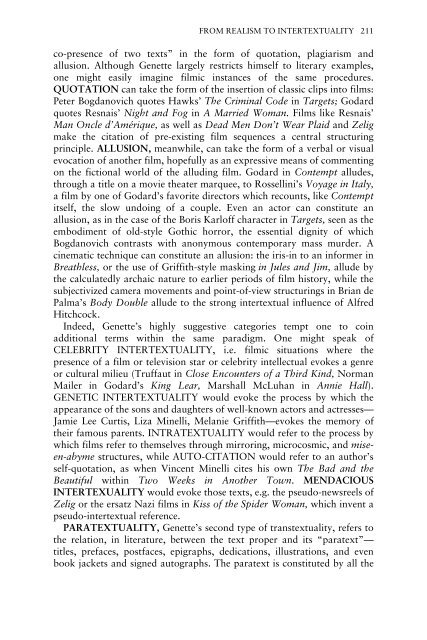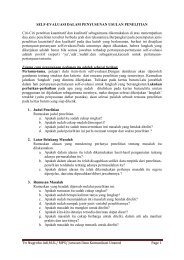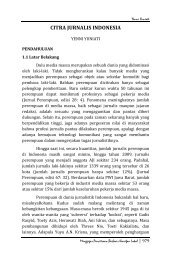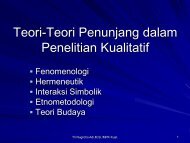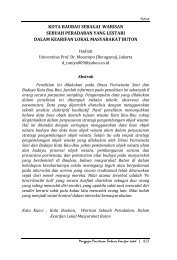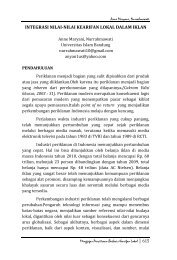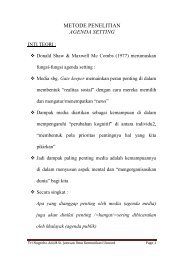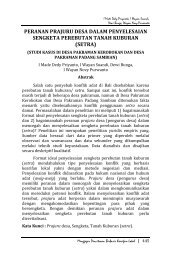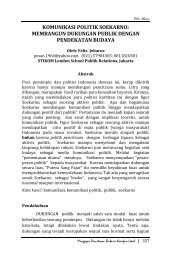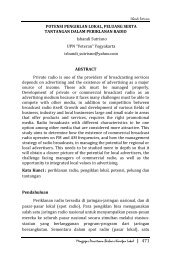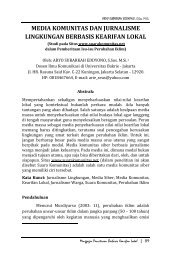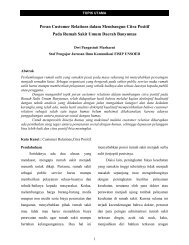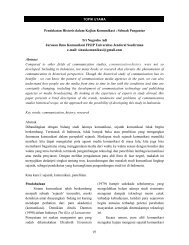New Vocabularies in Film Semiotics
New Vocabularies in Film Semiotics
New Vocabularies in Film Semiotics
Create successful ePaper yourself
Turn your PDF publications into a flip-book with our unique Google optimized e-Paper software.
FROM REALISM TO INTERTEXTUALITY 211<br />
co-presence of two texts” <strong>in</strong> the form of quotation, plagiarism and<br />
allusion. Although Genette largely restricts himself to literary examples,<br />
one might easily imag<strong>in</strong>e filmic <strong>in</strong>stances of the same procedures.<br />
QUOTATION can take the form of the <strong>in</strong>sertion of classic clips <strong>in</strong>to films:<br />
Peter Bogdanovich quotes Hawks’ The Crim<strong>in</strong>al Code <strong>in</strong> Targets; Godard<br />
quotes Resnais’ Night and Fog <strong>in</strong> A Married Woman. <strong>Film</strong>s like Resnais’<br />
Man Oncle d’Amérique, as well as Dead Men Don’t Wear Plaid and Zelig<br />
make the citation of pre-exist<strong>in</strong>g film sequences a central structur<strong>in</strong>g<br />
pr<strong>in</strong>ciple. ALLUSION, meanwhile, can take the form of a verbal or visual<br />
evocation of another film, hopefully as an expressive means of comment<strong>in</strong>g<br />
on the fictional world of the allud<strong>in</strong>g film. Godard <strong>in</strong> Contempt alludes,<br />
through a title on a movie theater marquee, to Rossell<strong>in</strong>i’s Voyage <strong>in</strong> Italy,<br />
a film by one of Godard’s favorite directors which recounts, like Contempt<br />
itself, the slow undo<strong>in</strong>g of a couple. Even an actor can constitute an<br />
allusion, as <strong>in</strong> the case of the Boris Karloff character <strong>in</strong> Targets, seen as the<br />
embodiment of old-style Gothic horror, the essential dignity of which<br />
Bogdanovich contrasts with anonymous contemporary mass murder. A<br />
c<strong>in</strong>ematic technique can constitute an allusion: the iris-<strong>in</strong> to an <strong>in</strong>former <strong>in</strong><br />
Breathless, or the use of Griffith-style mask<strong>in</strong>g <strong>in</strong> Jules and Jim, allude by<br />
the calculatedly archaic nature to earlier periods of film history, while the<br />
subjectivized camera movements and po<strong>in</strong>t-of-view structur<strong>in</strong>gs <strong>in</strong> Brian de<br />
Palma’s Body Double allude to the strong <strong>in</strong>tertextual <strong>in</strong>fluence of Alfred<br />
Hitchcock.<br />
Indeed, Genette’s highly suggestive categories tempt one to co<strong>in</strong><br />
additional terms with<strong>in</strong> the same paradigm. One might speak of<br />
CELEBRITY INTERTEXTUALITY, i.e. filmic situations where the<br />
presence of a film or television star or celebrity <strong>in</strong>tellectual evokes a genre<br />
or cultural milieu (Truffaut <strong>in</strong> Close Encounters of a Third K<strong>in</strong>d, Norman<br />
Mailer <strong>in</strong> Godard’s K<strong>in</strong>g Lear, Marshall McLuhan <strong>in</strong> Annie Hall).<br />
GENETIC INTERTEXTUALITY would evoke the process by which the<br />
appearance of the sons and daughters of well-known actors and actresses—<br />
Jamie Lee Curtis, Liza M<strong>in</strong>elli, Melanie Griffith—evokes the memory of<br />
their famous parents. INTRATEXTUALITY would refer to the process by<br />
which films refer to themselves through mirror<strong>in</strong>g, microcosmic, and miseen-abyme<br />
structures, while AUTO-CITATION would refer to an author’s<br />
self-quotation, as when V<strong>in</strong>cent M<strong>in</strong>elli cites his own The Bad and the<br />
Beautiful with<strong>in</strong> Two Weeks <strong>in</strong> Another Town. MENDACIOUS<br />
INTERTEXUALITY would evoke those texts, e.g. the pseudo-newsreels of<br />
Zelig or the ersatz Nazi films <strong>in</strong> Kiss of the Spider Woman, which <strong>in</strong>vent a<br />
pseudo-<strong>in</strong>tertextual reference.<br />
PARATEXTUALITY, Genette’s second type of transtextuality, refers to<br />
the relation, <strong>in</strong> literature, between the text proper and its “paratext”—<br />
titles, prefaces, postfaces, epigraphs, dedications, illustrations, and even<br />
book jackets and signed autographs. The paratext is constituted by all the


